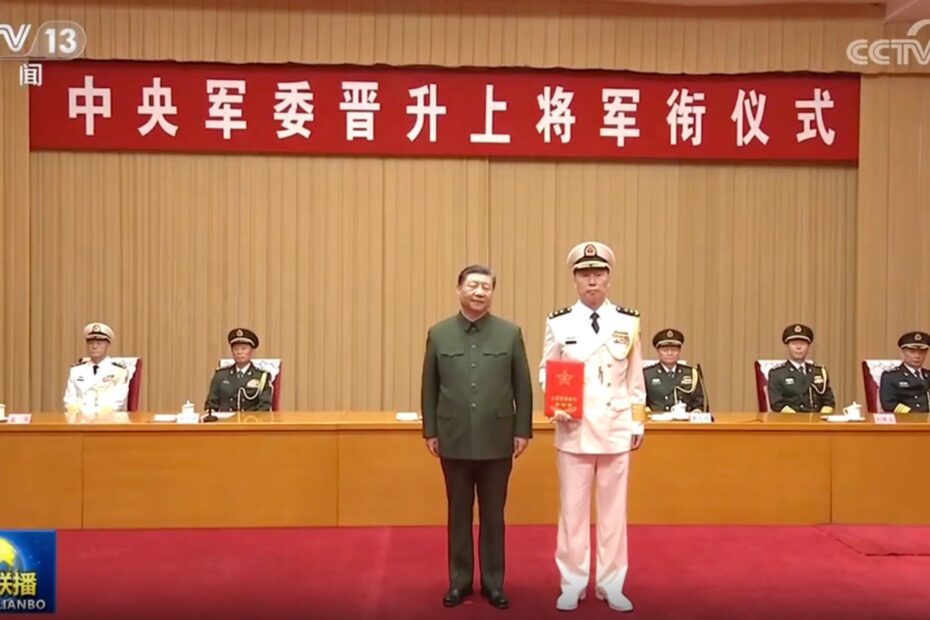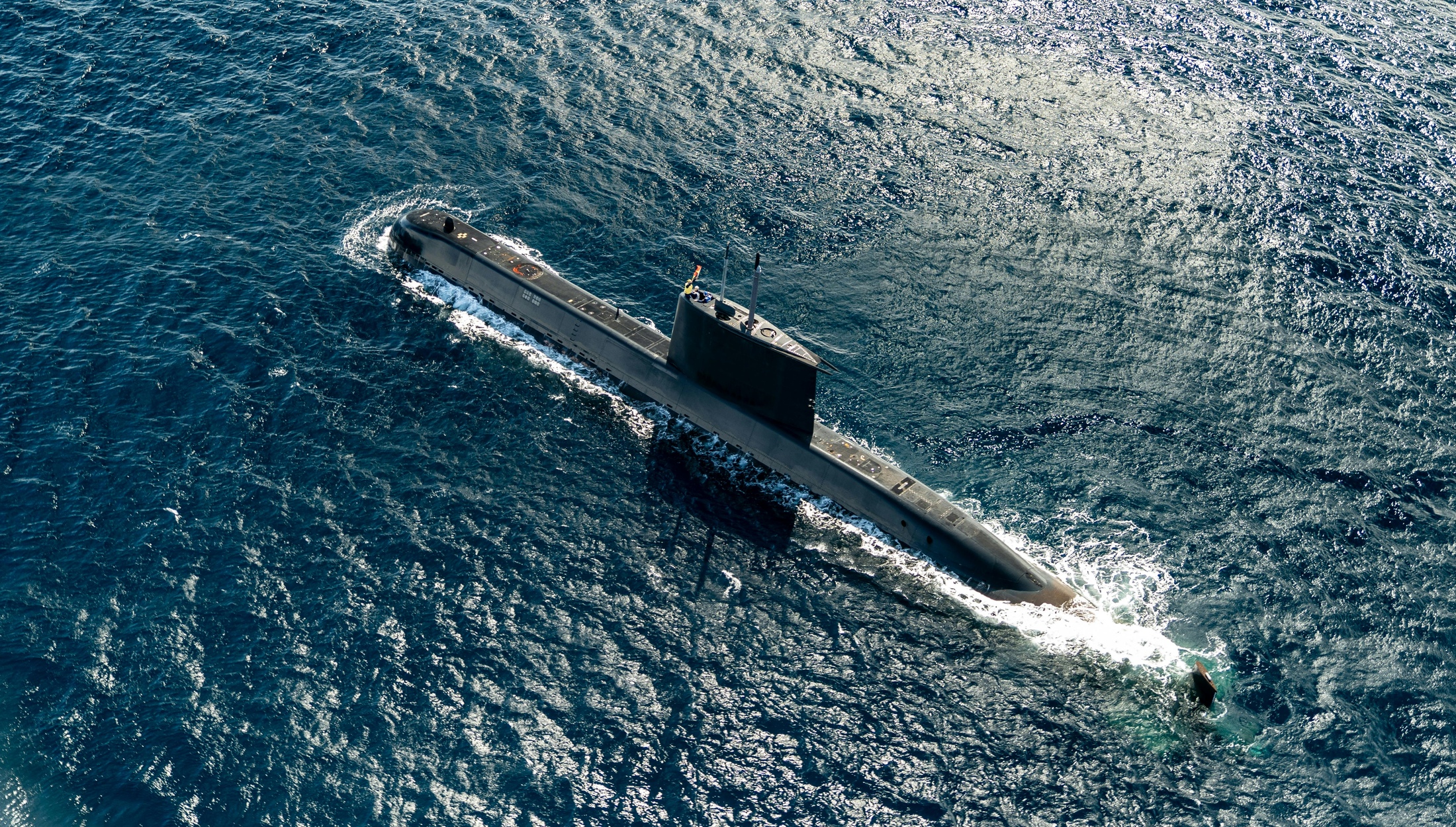Xi Jinping and the new PLAN Chief Adm. Hu Zhongming on Dec. 25, 2023. (Photo Credit: US Naval Institute/DZIRHAN MAHADZIR/CCTV Image)
There is no doubt that the year 2023 is ending with much celebration over the achievement of several milestones and accomplishments for Australia, the US, and the UK who are all part of a trilateral security pact widely known as AUKUS pact. The year 2024 is expected to witness more progress and developments.
In the wake of AUKUS development which is going to become a game changer for the Indo-Pacific region, China recently appointed its submariner Hu Zhongming as top People’s Liberation Army Navy (PLAN) commander on the eve of Christmas. In addition to this appointment, China has named its former navy chief Dong Jun as its new defence minister on 29 December 2023 who will be filling a vacancy created by the removal of Li Shangfu in October 2023.
The latest appointments of Hu Zhongming and Dong Jun is a message to the AUKUS nations as their expertise will benefit China in the long run and hence it is worrisome as both have got a proven track record in nuclear submarines.
As of 2023, China possesses six nuclear-powered ballistic missile submarines (SSBNs), six nuclear-powered attack submarines (SSNs), and 47 diesel/air-independent propulsion powered attack submarines (SSs) as per Table 1.
Table 1: Number of Chinese submarines, 2005 – 2023
| Year | Number of nuclear-powered ballistic missile submarines (SSBN) | Number of nuclear-powered attack submarines (SSN) | Number of diesel/air-independent propulsion powered attack submarines (SS) |
| 2005 | 1 | 6 | 51 |
| 2006 | 1 | 5 | 50 |
| 2007 | 1 | 5 | 53 |
| 2008 | 1 | 5 | 54 |
| 2009 | 2 | 6 | 54 |
| 2010 | 2 | 6 | 54 |
| 2011 | 2 | 5 | 49 |
| 2012 | 2 | 5 | 48 |
| 2013 | 3 | 5 | 49 |
| 2014 | 3 | 5 | 51 |
| 2015 | 4 | 5 | 53 |
| 2016 | 4 | 5 | 57 |
| 2017 | 4 | 5 | 54 |
| 2018 | 4 | 5 | 57 |
| 2019 | 4 | 6 | 50 |
| 2020 | 4 | 6 | 46 |
| 2021 | 6 | 9 | 56 |
| 2022 | 6 | 6 | 56 |
| 2023 | 6 | 6 | 47 |
Note: The numbers for 2005 column show the figure for the end of FY2004, and so on for later years.
Given the ongoing tensions in the Indo-Pacific, South China Sea, and elsewhere, China is constantly focusing on developing a robust naval prowess to challenge the presence of the US and its allies in the Indo-Pacific region. Therefore, China’s progress in the acquisition of submarine capabilities is worrisome and it will fuel a submarine race in the region. This is evident from Table 2, as the number of submarines China will possess in 2030 will be 76 compared to 62 in 2000.
China has openly opposed the AUKUS pact and claims that the pact will risk the global security and it violates Treaty on the Non-Proliferation of Nuclear Weapons (NPT). However, as per Table 2, China is seen to be ramping up its own nuclear submarine fleet (both SSBN and SSN) from 6 in 2000 to 21 by 2030.
Table 2: Number of Chinese submarines, 2000 – 2030
| Type of submarine | 2000 | 2005 | 2010 | 2015 | 2020 | 2025 | 2030 |
| Number of nuclear-powered ballistic missile submarines (SSBN) | 1 | 1 | 3 | 4 | 4 | 6 | 8 |
| Number of nuclear-powered attack submarines (SSN) | 5 | 4 | 5 | 6 | 7 | 10 | 13 |
| Number of diesel/air-independent propulsion powered attack submarines (SS) | 56 | 56 | 48 | 53 | 55 | 55 | 55 |
| Total | 62 | 61 | 56 | 63 | 66 | 71 | 76 |
Note: Figures are for end of calendar year
China has been reportedly found introducing new YAUN-class submarines (Type 039C) which are approximately 25 or more in number and will be delivered by 2025 according to the 2023 annual report titled ‘Annual Report to Congress: Military and Security Developments Involving the People’s Republic of China’ published by the US Department of Defence. The report also states the number of submarine types and classes that China has in possession as of year 2023.
Table 3: Number of Chinese submarines, 2023 – Current
| Number of nuclear-powered ballistic missile submarines (SSBN) | 6 |
| JIN-class, Type 094 | 6 |
| Next generation SSBNs | Number unknown |
| Number of nuclear-powered attack submarines (SSN) | 6 = (2 + 4) |
| SHANG I – class, Type 093 | 2 |
| SHANG II – class, Type 093A | 4 |
| Number of guided-missile nuclear attack submarines (SSGN) | 5 = (2 + 3) |
| SHANG III – class, Type 093B | 2 |
| SHANG III – class, Type 093B | 3 hulls are available |
| Number of diesel/air-independent propulsion powered attack submarines (SS) | 44 = (13 + 21 + 8 + 2) |
| SONG-class, Type 039 | 13 |
| YUAN-class, Type 039 A/B | 21 |
| KILO-class with anti-ship cruise missiles (ASCM) | 8 |
| KILO-class without ASCM | 2 |
| KILO-class without ASCM, decommissioned in 2021 | -2 |
| New YUAN-class, Type 039C | 25 |
By discarding its old Russian KILO-class submarines which China got in 1990s, China is now looking to be more focused on qualitative over quantitative submarine fleet which will be equipped with advance technology, stealth, endurance and armament to maintain its force posture and modernization. With the appointment of Hu Zhongming and Dong Jun, China hopes to give impetus to its ongoing naval and maritime defence modernization programs where submarines are crucial for China to act as a nuclear deterrent at sea.



